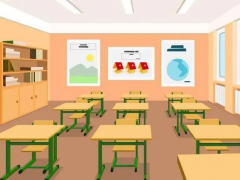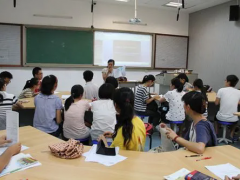小学英语全英说课稿范文
小学英语全英文说课稿
Good morning, everyone! Today, I'll say something about Unit 9 Part A in Book 4 of Oxford English. Background on the reformation of curriculum, this book can connect the life and act, emphasize the interest and experience of the Ss, the pictures are active and vivid. Grade four is the initial stage of English learning, so it stresses on the emotion of the Ss, creates a well beginning for the Ss. This Unit has 7 parts, we'll learn Part A mainly, it embodies the repeating characterize. Review the learned language points “Where's…”and the new language points will be represented in the following units. So this unit forms connecting links with a special meaning in this book. The content of this period is to use “Where'sare…” to determine the place. And according to the contents and the fact of the Ss, I establish the following three teaching aims of this period: The first one: students can listen, read, say and spell the following words: a glass, a fridge, an egg, bread and a table. The second one: students can listen, read, say and write the following daily expressions: What's for breakfast? Have some juice then. The third one: students can listen, read, say and write the following sentence patterns: Where'sWhere are themy… It's They're… There's no …in on near… I think the most difficult point of this period is to make sure the students can use the patterns “Where'sWhere are…and There is no …inonnear…” in their daily life correctly. And I will use some pictures, words and sentence cards, a tape recorder and the multi-media computer to help me achieve the aims. The task-based method, communicated method, group cooperate method will be used in this period. To accomplish the aims, I design the following steps: Step 1 Songs and the game arousers the emotion. In order to attract the Ss' attention and construct an atmosphere of learning English, I let the students sing some English songs and play the game “Simon says”. At the same time the game can review the prep, serve the knowledge as foil and consist the appearance of the knowledge. Step 2 Change class to life, happy to say. The substance of language is communication and the environment of communication is life. So when I present the sentence pattern “What's for breakfast?” I first show a clock to elicit the time for breakfast, teach the sentence. Then show my own photo of having breakfast, Ss ask and guess. In this way I can attract Ss' attention, encourage Ss to ask Qs with the new knowledge. Most of the Ss have learnt the sentence pattern: Where's…? so I design a task for Ss to help Helen find the food and drinks for breakfast, and teach the new language points: Where are…? They're … Meanwhile stick the sentences on the Bb. After some practice by asking and answering, I present the next language points: There's no …inonnear… Have …then. And I will stick these sentence patterns on the Bb. Finally I'll let the Ss do pair works to consolidate them. Step 3 Listen to the tape and Ss imitate to read and say. As the new reformation of curriculum, emphasized the traditional class attach importance to the mechanical teaching, neglect the experience and participation, for example, the five-step method. So in this lesson, after presentation, I ask Ss to listen to the tape with three Qs, read in different roles and in pairs, then try to recite the text. Step 4 Ss be the main body, T makes a guider. In class, Ss play as a host, and the T makes an influence on guiding, help Ss to act the learnt dialogue, it can stress the position of the Ss, and arouse their interest. Then I show a carton with no voice, ask Ss to make a dialogue in pairs. There are lots of ways to consolidate the new knowledge. Playing game is a good way. So according to the physiology of Ss, I hold a group competition during the game, ask Ss to finish the blanks. In this way can develop Ss' good habits and achieve the aim of mastering the learned knowledge in situation. Step 5 Change class to life, learn by themselves. Is this the end of the class? I don't think so. If there is an end, I think it should be in the life. So I extend this class, encourage Ss to use the learned to communicate with each other in their life. In a word, the whole period is based on tasks, which are designed from easy steps to steps that are challenging. When the Ss are carting out the tasks, they can acquire information, knowledge, and have their ability and skills trained. That's all. Thanks a lot for your attention.。
小学英语全英文说课稿
我只知道小学应该这么讲先说Class begins,good morning/afternoon boys and girls.再说Do you know xxx?It's xxx(adj).Open your book and turn to page xxx,today we'll learn something about it/them.然后开始讲课就行了讲课中常用的:Practice in pairs(两人一组练对话)Open your bookClose your bookDo you have any questions?Look at blackboard.Write down some notes(做笔记)Stand up please.Ok,sit down.Listen to me.Let'splay a gameWho wants to have a try?(谁想试一试)最后Now class is over,see you next time.Thank you。
.。
小学英语外研社新标准一起说课稿 越多越好
It's my great honor to be here sharing my lesson with you.The content of my lesson is《New Standard English 》Book4 Module8 Unit1 I was two. Then I'm going to talk about it through the following six aspects: teaching material, students, teaching aims, teaching points, teaching preparation and teaching process.一、Teaching materialThe topic of this module is “Changes”. The language function of this unit is throughing the photos of Lingling's grandparents and her own to describe the things past with “was/were”. The main patterns “They were young.” and “I was two.” are close to Ss' daily life. Therefore, they would show their great interests in this lesson and try to use what they have learnt in their real lives. By studying this unit, Ss can discuss the things that occurred in the past to themselves with “was/were”.二、StudentsThe Ss in grade four have got some English foundations. They also have higher learning enthusiasm and lively personalities. As a result, the activities full of fun and relaxation are offered in order to let the Ss learn English more freely. Meanwhile, the abilities of observing and self-study , the habits of independent thinking and positive participation are fostered in the class.三、Teaching aims(一)Aims on the knowledge1.The Ss can understand and speak the words: who, grandparents, then, me, hair, so.2.The Ss can understand and speak the sentence patterns: They were young. I was two.(二)Aims on the abilities1.The Ss can read the dialogue fluently.2.The Ss can communicate with “was/were” according to the photos.(三)Aims on the emotionThrough the Ss' comparison the old life with the new one, they will not only cherish the life nowadays, but also improve emotion between the families.四、Teaching points(一)Key points1.The Ss can understand and speak the new words and the sentence patterns.2.The Ss can describe the things past with “was/were”.(二)Difficult points1.The Ss know the usage and relationship between “am/is/are” and “was/ were”. 2.The Ss can discuss the real life with the sentence patterns freely and creatively.五、Teaching preparationTape, recorder, photos, multimedia, cards, stickers. 六、Teaching processStep 1 .Warming-up1. Greetings2. Enjoy the song “The family”.3. Free talkT: Here is a family photo. Let's describe it. In this photo, Father is … (choose the appropriate adjectives) S: ….T: Mother/Brother/Sister/Baby is……[Design intent] The song can adjust the Ss' thought, arouse their interest in learning English, let them enter the atmosphere of learning English quickly.The free talk can help them review the adjectives which are used to describe the personalities and characters.Step 2.Presentation1. Leading- inT: Here is another family photo. Do you know who the baby is?S: …T: It's me! ( Teach the word “me” at this moment.) I was two, then. Now I am 30. (Show Ss the current photo.)T: Our friend Lingling has got some photos, too. Do you want to have a look? [Design intent] Through the new and old photos show, bring out the topic of the text smoothly and make a good preparation for the text learning. 2. Text(1)Listen and try to find out the words they don't know. Study them in groups. Then T consolidates the meaning of “who, grandparents, then, hair, so”.(2)Listen read and underline the sentences with “was/were”. T: What's the difference between “am/is/are” and “was/ were”? (Explain it under the help of the photos.)[Design intent] Through the listening and underlining, Ss can have the deeper understanding to the text. Explain the past tense appropriately and design the blackboard writing reasonably. Let Ss know the meaning and usage of “was/ were” clearly.(3)Listen and read the dialogue again.Step 3.Practice1.Look, listen and guess.Show Ss four pairs of pictures, choose the correct one after listening to T's description.2.Do Activity 3 on page 31. Discuss the answers in groups. [Design intent] Through the activities, let Ss practice the sentence patterns step by step. Cultivate Ss' abilities of cooperation and participation by group-working. Step 4 Consolidation1.Enjoy the passage of the cartoon “The ugly duckling”. Discuss the changes of the little duckling according to the T's reminder.2. Show Ss some photos of new and old Yantai, let them realize the great changes of our life.[Design intent] The cartoon can make Ss show more interests in learning English. Through the photos show, Ss will love and cherish the new life more.Step 5 SummaryAsk Ss themselves to summarize what they have learnt today. Step 6 Assignment1.Listen and 。
英语说课模版
ⅠToday , I'm going to talk about my plan for teaching ….First, I'd like to say something about the teaching content . …Second, the aims of this lesson are:1. Knowledge of language: …2. Pratical skills …3. Personal development …Third, the focus and difficulties are: ….Next, my way of teaching.Teaching English at primary schools aims at students' basic skills in listening and speaking and the their interest in English. So I find it necessary to design a task-based class: students will be assigned to do a survey. This task will make it possible for the students to pick up the language in an authentic way. Teaching aids: a recorder, sentences cards , stationary ,pictures, head ornaments and a form. I shall have the students join in the singing, ridding guessing and doing a survey .I'm going to take the following procedures:Step 1 Warm-upStep2 PresentationStep3 PracticeStep 4 ConsolidationStep 5 Assignment ⅡIt's my pleasure to be here. Now, I'd like to say something about my teaching plans about …For its objective, it covers …objectives1. Knowledge objective …2. Ability objective …3. Moral objective …During the procedure of my teaching, multi-media, over head project, tape recorder, pictures will surely be adopted that will also be accompanied by demonstration, role-playing, task-oriented approach. Through these methods and by using these aids, I want to teach the students how to be successful language learners.After analyzing the dialogue, I set off my teaching plan around 4 tasks and many activities: pre-task, while-task, post-task and creative task. … That's my idea about the teaching plan of this lesson. Thanks for listening.。
pep小学英语说课
PEP小学英语第四册Unit6 At the farm说课稿一、说教材我说课的内容是PEP小学英语四年级下学期Unit6的第二课时--- Let's talk 1.教学内容第六单元的教学内容都是围绕“farm”这个主题展开的。
本节课为第二课时,对话教学.虽然已经学习了农场上的一些动物,但是其复数形式还没有学习,所以这一课要先学习单词的复数形式,在此基础上再进行问答的练习。最后能组句成段,串联起来,相互交流、表演。
这也是本课的最终所要达到的效果。 2.教学目标英语课程标准指出,基础教育阶段英语课程的总体目标是培养学生的综合语言运用能力。
而综合语言运用能力又以学生语言技能、语言知识、情感态度、学习策略和文化意识五个方面的综合素养为基础。基于以上认识,对教学内容的分析以及本教材的特点,我将教学目标确定为:(1)知识目标:能够熟练运用句型 “ They are…” “ Are they…?” “ How many…?” (2) 能力目标:能够听说认读句型,并能在一定情景中正确运用。
(3) 情感目标:提高学生的口语表达能力和交际能力。培养学生热爱动物,热爱自然的良好感情。
3.教学重、难点:依据以上对教学内容和教学目标的分析以及小学生的认识规律和英汉语言差异,我认为本课时的教学重点就是熟练运用句型“ They are…” “ Are they…?” “ How many…?”,并能串联起来,进行交流。难点是个别单词的复数形式,如:sheep的复数仍是sheep,以及最后的情景表演。
二.说教学方法:在新授阶段,我主要借助多媒体辅助法、实物教学法来呈现材料,激发学生的学习兴趣和求知欲;在操练阶段,我运用观察法,情景教学法,多媒体辅助法等,开展任务型活动,来巩固知识,发展学生的语言实践能力,培养学生的创新精神。三.说教学过程1. 热身阶段:歌曲导入,引出新知欣赏歌曲 “Old Macdonald”谈论听到的动物。
What did you hear ? Dog… (由学生熟悉的歌曲开始,既活跃课堂,锻炼听力,也为整堂课创设了良好的氛围。)2.呈现阶段: (1) 猜谜语,组成新单词It has no legs. It can swim in the water. (fish)It is very small. It is always on the floor. ( ant)It has red eyes and long ears. (rabbit)It can climb trees. It likes eating bananas. (monkey)这些单词的第一个字母组成新的单词——farm.(利用学生喜欢的猜谜练习,由此组成新单词,为下一环节做铺垫)(2)一起去农场游玩,首先通过听声音,来猜动物,结合板书一起进行。
黑板上设计成六个小方块,作为动物的家。猜对一个动物,就在黑板上呈现一个动物。
当动物一一呈现时(通过听声辨动物的游戏,复习所学的农场上的动物。)(3) 通过比较,教学单词的复数形式。
One cow, two cows…在黑板上增添动物,同时更换板书,把cow变成cows…( 简洁、形象地利用图片进行教学,学生容易理解。)(4)教学 “ They are…”教师利用手中的图片,让学生进行练习。
当然,句型可以是多样化的。同时,若学生说对,就把图片给他们。
当只剩下一个是,复数就变成了单数,要求学生也能转换。(利用图片奖励的方式,操练句型,新鲜有趣。)
(5)用课件,展示两幅不清楚的图片,让学生进行猜测,学习句型 Are they…? Yes, they are. No, they aren't.请学生运用黑板上的图片,两人一组操练句型。若说的正确,可取一张图片。
(充分利用图片,又把图片当作奖励。)(6)教师把黑板上的单词卡片转移到分布在教室其他地方的板上,然后让学生把自己手中的图片贴在相应的位置。
到底有多少动物呢?翻出藏在板后面的数字,学习句型。How many… do you have? One hundred.其他动物的数量,可直接翻出,也可让学生猜。
当数字全部出现后,学生两人操练,一人为农场主,另一人做采访。(7)学习课文。
“ It's a big farm. The farmer is very happy. Mike , Sarah and John are talking with him.” 在听之前先给出三句问句,听得更有意义。一起朗读课文。
3.拓展与延伸学习语言的最终目的在于交际。课堂的终点在哪里?如果有,我想应该在生活中。
因此,在课堂教学的最后环节时,我设计了这样一个活动- 参观农场。即一个学生扮演农场主,另一个扮演拜访者,进行情景操练。
采访完成,一起合影。学生可扮演各种各样的动物,数到三时,停下不动,然后拍照。
趣味游戏。5.愉快结束 利用课件呈现一些动物的图片,并与它们说再见,愉快的旅程结束。
四.说板书设计 这节课的板书我主要采用单词、句子与图片共同呈现的方式进行的。同时,这些内容又是多种作用的。
有呈现,有操练,也有作为奖励的。力争把板书也变得有滋有味。






